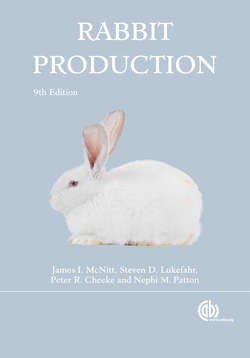Читать книгу Rabbit Production - James I McNitt - Страница 28
На сайте Литреса книга снята с продажи.
Purchasing Breeding Stock
ОглавлениеAfter it has been decided which breed of rabbit one wishes to raise, lists of breeders who have that particular stock for sale can be obtained from the officers of the local, state, and specialty rabbit clubs and from the home office of the American Rabbit Breeders Association. (Most countries have similar organizations.) County extension agents are another source of names of rabbit raisers. Advertisements in rabbit journals and other periodicals that carry classified ads are good sources of listings. One should, however, avoid the flashy type of advertisement proclaiming that a fortune can be made from raising rabbits, for this is not true, although an experienced, conscientious, industrious person with proper equipment and a well-selected herd should be able to realize a reasonable return.
When an entire herd is being sold, it is well to inquire carefully into the reasons, as such sales may or may not be excellent opportunities for buying good, healthy breeding stock. It is always best to deal with reputable breeders, and the inexperienced will do well to depend on the advice of one or several established breeders in selecting animals. The source rabbitry should be clean and well managed, with no observable snuffles (respiratory tract infections) or other disease problems. It is never economical to purchase inferior breeding stock, for one good producing doe may make more profit than several inferior ones.
The novice is advised to begin rabbit raising on a small scale, preferably with 1 or 2 bucks and 2 to 10 does, then to expand as experience and the market outlet would indicate. He or she may start with a few junior animals when they are weaned or with mature stock. The former method offers an opportunity to become acquainted with the animals and to gain experience in the business before handling too many rabbits; the latter method may be quicker, but naturally the stock will cost more.
However, when rabbits are to be purchased for raising by a younger member of the family, the additional cost of an adult doe may be justified because youth demands action. Having to supply a nest box and nesting material, preparing for the kindling of the doe, and caring for the litter, followed by marketing the meat, skins, or animals, might help maintain the young person’s interest in the undertaking at a time when it might be lagging. Then, on receiving some income from the sale of the products, he or she is ready to go on and plan for another litter. On the other hand, if the stock is purchased at eight weeks of age, or at time of weaning, it seems like a long wait for the young rabbit raiser before the animals are ready to go into production, and he or she may lose interest.
When mature does are moved to a new rabbitry, there are often problems with their first litters, including poor nest making, litters born on the wire (i.e., the doe doesn’t use the nest box), abandoning of litters, cannibalism, fetal abnormalities, and resorptions. Pregnant does should not be purchased, because the move to a new rabbitry may cause a great deal of stress possibly leading to reproductive failure.
In purchasing stock, use great care to avoid diseases. Newly purchased animals should be quarantined before allowing them to mix with other animals. From a genetics point of view, it is desirable to obtain stock from a number of different sources to get genetic diversity, but from a disease point of view, it can be a problem if the rabbits are not checked carefully and quarantined for at least two weeks. Another way to accomplish this is to obtain bucks from different sources and quarantine them before using them in the herd.
When buying stock, ask to see the records. If you are buying commercial stock, find out what selection procedures have been used. Get information on litter sizes and 21- and 56-day litter weights. Generally, the best stock for meat production comes from successful commercial rabbit raisers. Many people start with a trio of two does and a buck, which should not be littermates. They should be carefully examined for soundness, good foot pads, normal teeth, good fur quality, and absence of ear mites and other pests and diseases. It is very important to start your rabbitry with the highest quality stock you can obtain. If you have had no rabbit experience, start with no more than 10 to 20 does. Find out whether you really want to raise rabbits. If you find that you do enjoy it, then increase by buying more breeding stock. Two hundred breeding does is a minimum economic unit. Rabbitries smaller than this do not make effective use of large quantity purchase discounts for feed, supplies, cages, and other equipment. The cost of selling fryers may also be greater for small producers, as they usually have to transport their fryers to pick-up points, while the truck usually comes directly to a large rabbitry. It is advisable to buy no more than 100 does, and then increase by saving your own replacements. A full-time rabbit operation for one person is about 300 does. If breeding stock is being purchased from a small herd, it is advisable to get the bucks from a different source than the does for maximum genetic diversity.
If you are doing any custom breeding, keep one or more bucks in isolation for that purpose. Never use your buck on someone else’s does and then return the buck to your herd. Custom breeding is an easy way to introduce rabbit syphilis and other diseases into your herd.
